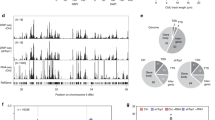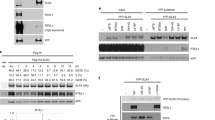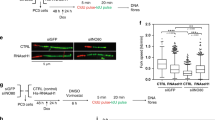Abstract
Topoisomerase I (Top1) is a key enzyme in functioning at the interface between DNA replication, transcription and mRNA maturation. Here, we show that Top1 suppresses genomic instability in mammalian cells by preventing a conflict between transcription and DNA replication. Using DNA combing and ChIP (chromatin immunoprecipitation)-on-chip, we found that Top1-deficient cells accumulate stalled replication forks and chromosome breaks in S phase, and that breaks occur preferentially at gene-rich regions of the genome. Notably, these phenotypes were suppressed by preventing the formation of RNA–DNA hybrids (R-loops) during transcription. Moreover, these defects could be mimicked by depletion of the splicing factor ASF/SF2 (alternative splicing factor/splicing factor 2), which interacts functionally with Top1. Taken together, these data indicate that Top1 prevents replication fork collapse by suppressing the formation of R-loops in an ASF/SF2-dependent manner. We propose that interference between replication and transcription represents a major source of spontaneous replication stress, which could drive genomic instability during the early stages of tumorigenesis.
This is a preview of subscription content, access via your institution
Access options
Subscribe to this journal
Receive 12 print issues and online access
$209.00 per year
only $17.42 per issue
Buy this article
- Purchase on Springer Link
- Instant access to full article PDF
Prices may be subject to local taxes which are calculated during checkout







Similar content being viewed by others
Accession codes
References
Aladjem, M. I. Replication in context: dynamic regulation of DNA replication patterns in metazoans. Nature Rev. Genet. 8, 588–600 (2007).
Ivessa, A. S. et al. The Saccharomyces cerevisiae helicase Rrm3p facilitates replication past nonhistone protein-DNA complexes. Mol. Cell 12, 1525–1536 (2003).
Tourriere, H. & Pasero, P. Maintenance of fork integrity at damaged DNA and natural pause sites. DNA Repair 6, 900–913 (2007).
Aguilera, A. & Gomez-Gonzalez, B. Genome instability: a mechanistic view of its causes and consequences. Nature Rev. Genet. 9, 204–217 (2008).
Bartkova, J. et al. Oncogene-induced senescence is part of the tumorigenesis barrier imposed by DNA damage checkpoints. Nature 444, 633–637 (2006).
Di Micco, R. et al. Oncogene-induced senescence is a DNA damage response triggered by DNA hyper-replication. Nature 444, 638–642 (2006).
Halazonetis, T. D., Gorgoulis, V. G. & Bartek, J. An Oncogene-Induced DNA damage model for cancer development. Science 319, 1352–1355 (2008).
Azvolinsky, A., Giresi, P. G., Lieb, J. D. & Zakian, V. A. Highly transcribed RNA polymerase II genes are impediments to replication fork progression in Saccharomyces cerevisiae. Mol. Cell 34, 722–734 (2009).
Nickoloff, J. A. & Reynolds, R. J. Transcription stimulates homologous recombination in mammalian cells. Mol. Cell. Biol. 10, 4837–4845 (1990).
Gottipati, P., Cassel, T. N., Savolainen, L. & Helleday, T. Transcription-associated recombination is dependent on replication in mammalian Cells. Mol. Cell. Biol. 28, 154–164 (2008).
Pommier, Y. Topoisomerase I inhibitors: camptothecins and beyond. Nature Rev. Cancer 6, 789–802 (2006).
Champoux, J. J. DNA toppoisomerases: structure, function, and mechanism. Annu. Rev. Biochem. 70, 369–413 (2001).
Thrash, C., Bankier, A. T., Barrell, B. G. & Sternglanz, R. Cloning, characterization, and sequence of the yeast DNA topoisomerase I gene. Proc. Natl Acad. Sci. USA 82, 4374–4378 (1985).
Zhang, C. X., Chen, A. D., Gettel, N. J. & Hsieh, T. S. Essential functions of DNA topoisomerase I in Drosophila melanogaster. Dev. Biol. 222, 27–40 (2000).
Miao, Z.-H. et al. Nonclassic functions of human topoisomerase I: genome-wide and pharmacologic Analyses. Cancer Res. 67, 8752–8761 (2007).
Rossi, F. et al. Specific phosphorylation of SR proteins by mammalian DNA topoisomerase I. Nature 381, 80–82 (1996).
Soret, J. et al. Altered serine/arginine-rich protein phosphorylation and exonic enhancer-dependent splicing in mammalian cells lacking topoisomerase I. Cancer Res. 63, 8203–8211 (2003).
Malanga, M., Czubaty, A., Girstun, A., Staron, K. & Althaus, F. R. Poly(ADP-ribose) binds to the splicing factor ASF/SF2 and regulates its phosphorylation by DNA Topoisomerase I. J. Biol. Chem. 283, 19991–19998 (2008).
Li, X. & Manley, J. L. Inactivation of the SR protein splicing factor ASF/SF2 results in genomic instability. Cell 122, 365–378 (2005).
Rogakou, E. P., Boon, C., Redon, C. & Bonner, W. M. Megabase chromatin domains involved in DNA double-strand breaks in vivo. J. Cell Biol. 146, 905–916 (1999).
Coquelle, A., Pipiras, E., Toledo, F., Buttin, G. & Debatisse, M. Expression of fragile sites triggers intrachromosomal mammalian gene amplification and sets boundaries to early amplicons. Cell 89, 215–225 (1997).
Durkin, S. G. & Glover, T. W. Chromosome Fragile Sites. Annu. Rev. Genet. 41, 169–192 (2007).
Michalet, X. et al. Dynamic molecular combing: stretching the whole human genome for high- resolution studies. Science 277, 1518–1523 (1997).
Tourriere, H., Versini, G., Cordon-Preciado, V., Alabert, C. & Pasero, P. Mrc1 and tof1 promote replication fork progression and recovery independently of Rad53. Mol. Cell 19, 699–706 (2005).
Conti, C. et al. Replication fork velocities at adjacent replication origins are coordinately modified during DNA replication in human cells. Mol. Biol. Cell 18, 3059–3067 (2007).
Bjornsti, M. A., Benedetti, P., Viglianti, G. A. & Wang, J. C. Expression of human DNA topoisomerase I in yeast cells lacking yeast DNA topoisomerase I: restoration of sensitivity of the cells to the antitumor drug camptothecin. Cancer Res. 49, 6318–6323 (1989).
Hann, C. et al. Increased camptothecin toxicity induced in mammalian cells expressing Saccharomyces cerevisiae DNA topoisomerase I. J. Biol. Chem. 273, 8425–8433 (1998).
Misteli, T. et al. Serine phosphorylation of SR proteins is required for their recruitment to sites of transcription in vivo. J. Cell Biol. 143, 297–307 (1998).
Tazi, J. et al. Selective inhibition of topoisomerase I and various steps of spliceosome assembly by diospyrin derivatives. Mol. Pharmacol. 67, 1186–1194 (2005).
Holmes, W. F. et al. Coordinate control and selective expression of the full complement of replication-dependent histone H4 genes in normal and cancer cells. J. Biol. Chem. 280, 37400–37407 (2005).
Salceda, J., Fernandez, X. & Roca, J. Topoisomerase II, not topoisomerase I, is the proficient relaxase of nucleosomal DNA. EMBO J. 25, 2575–2583 (2006).
Bermejo, R. et al. Top1- and Top2-mediated topological transitions at replication forks ensure fork progression and stability and prevent DNA damage checkpoint activation. Genes Dev. 21, 1921–1936 (2007).
Anglana, M., Apiou, F., Bensimon, A. & Debatisse, M. Dynamics of DNA replication in mammalian somatic cells: nucleotide pool modulates origin choice and interorigin spacing. Cell 114, 385–394 (2003).
Courbet, S. et al. Replication fork movement drives remodeling of chromatin loops and origin choice in mammalian cells. Nature 455, 557–560 (2008).
Gilbert, D. M. Replication origin plasticity, taylor-made: inhibition vs recruitment of origins under conditions of replication stress. Chromosoma 116, 341–347 (2007).
Drolet, M. Growth inhibition mediated by excess negative supercoiling: the interplay between transcription elongation, R-loop formation and DNA topology. Mol. Microbiol. 59, 723–730 (2006).
Lin, S., Coutinho-Mansfield, G., Wang, D., Pandit, S. & Fu, X.-D. The splicing factor SC35 has an active role in transcriptional elongation. Nature Struct. Mol. Biol. 15, 819–826 (2008).
Guenther, M. G., Levine, S. S., Boyer, L. A., Jaenisch, R. & Young, R. A. A chromatin landmark and transcription initiation at most promoters in human cells. Cell 130, 77–88 (2007).
Kapranov, P. et al. RNA maps reveal new RNA classes and a possible function for pervasive transcription. Science 316, 1484–1488 (2007).
Kapranov, P., Willingham, A. T. & Gingeras, T. R. Genome-wide transcription and the implications for genomic organization. Nature Rev. Genet. 8, 413–423 (2007).
Das, R. et al. SR proteins function in coupling RNAP II transcription to pre-mRNA splicing. Mol. Cell 26, 867–881 (2007).
Wei, X. et al. Segregation of transcription and replication sites into higher order domains. Science 281, 1502–1505 (1998).
Vieira, K. F. et al. Recruitment of transcription complexes to the β-globin gene locus in vivo and in vitro. J. Biol. Chem. 279, 50350–50357 (2004).
Lengronne, A. & Schwob, E. The yeast CDK inhibitor Sic1 prevents genomic instability by promoting replication origin licensing in late G(1). Mol. Cell 9, 1067–1078 (2002).
Ekholm-Reed, S. et al. Deregulation of cyclin E in human cells interferes with prereplication complex assembly. J. Cell Biol. 165, 789–800 (2004).
Huvet, M. et al. Human gene organization driven by the coordination of replication and transcription. Genome Res. 17, 1278–1285 (2007).
Ge, X. Q., Jackson, D. A. & Blow, J. J. Dormant origins licensed by excess Mcm2 7 are required for human cells to survive replicative stress. Genes Dev. 21, 3331–3341 (2007).
Ibarra, A., Schwob, E. & Mendez, J. Excess MCM proteins protect human cells from replicative stress by licensing backup origins of replication. Proc. Natl. Acad. Sci. USA 105, 8956–8961 (2008).
Helmrich, A., Stout-Weider, K., Hermann, K., Schrock, E. & Heiden, T. Common fragile sites are conserved features of human and mouse chromosomes and relate to large active genes. Genome Res. 16, 1222–1230 (2006).
Widrow, R. J., Hansen, R. S., Kawame, H., Gartler, S. M. & Laird, C. D. Very late DNA replication in the human cell cycle. Proc. Natl. Acad. Sci. USA 95, 11246–11250 (1998).
Smogorzewska, A., Karlseder, J., Holtgreve-Grez, H., Jauch, A. & de Lange, T. DNA ligase IV-dependent NHEJ of deprotected mammalian telomeres in G1 and G2. Curr. Biol. 12, 1635–1644 (2002).
Versini, G. et al. The yeast Sgs1 helicase is differentially required for genomic and ribosomal DNA replication. EMBO J. 22, 1939–1949 (2003).
Pasero, P., Bensimon, A. & Schwob, E. Single-molecule analysis reveals clustering and epigenetic regulation of replication origins at the yeast rDNA locus. Genes Dev. 16, 2479–2484 (2002).
Verdun, R. E., Crabbe, L., Haggblom, C. & Karlseder, J. Functional human telomeres are recognized as DNA damage in G2 of the cell cycle. Mol. Cell 20, 551–561 (2005).
Acknowledgements
We thank M. Debatisse and M. Méchali for discussions and critical comments on the manuscript, D. Durocher for communicating data before publication, J. Piette for his initial contribution to this project and E. Schwob and the DNA combing facility of Montpellier for providing silanized coverslips. Work in the P.P. laboratory is supported by FRM (Equipe FRM), ANR, INCa and the EMBO Young Investigator Programme. Work in the J.T. laboratory is supported by ANR. A.C. is supported by the Ligue contre le cancer (Comité de l'Hérault), ARC (Association pour la Recherche contre le Cancer) and INCa. S.T., L.C. and H.T. were recipients of fellowships from ARC, EMBO and CNRS, respectively.
Author information
Authors and Affiliations
Contributions
A.C. and P.P. designed the project and wrote the paper; S.T., L.C., C.C. and H.T. performed most of the experiments; H.H.G. and A.J. performed the M-FISH studies; V.P. and J.D.V. performed microarray experiments. A.T. performed bioinformatic analyses; C.T. performed part of the DNA combing experiments; Y.P. and J.T. provided important experimental materials and advice and all authors contributed to interpreting the results and editing the manuscript.
Corresponding authors
Ethics declarations
Competing interests
The authors declare no competing financial interests.
Supplementary information
Supplementary Information Figures and Tables
Supplementary Information (PDF 696 kb)
Rights and permissions
About this article
Cite this article
Tuduri, S., Crabbé, L., Conti, C. et al. Topoisomerase I suppresses genomic instability by preventing interference between replication and transcription. Nat Cell Biol 11, 1315–1324 (2009). https://doi.org/10.1038/ncb1984
Received:
Accepted:
Published:
Issue Date:
DOI: https://doi.org/10.1038/ncb1984
This article is cited by
-
Dual roles of R-loops in the formation and processing of programmed DNA double-strand breaks during meiosis
Cell & Bioscience (2023)
-
NKAP acts with HDAC3 to prevent R-loop associated genome instability
Cell Death & Differentiation (2023)
-
APOBEC3B regulates R-loops and promotes transcription-associated mutagenesis in cancer
Nature Genetics (2023)
-
ZFP281-BRCA2 prevents R-loop accumulation during DNA replication
Nature Communications (2022)
-
Enhanced detection of expanded repeat mRNA foci with hybridization chain reaction
Acta Neuropathologica Communications (2021)



